Business Practice: Data Collection and Questionnaire Report
VerifiedAdded on 2022/12/27
|9
|1631
|83
Report
AI Summary
This report examines the application of data collection methods, specifically questionnaires, to address issues within a Small and Medium Enterprise (SME) context. The introduction highlights the importance of data in business decision-making, focusing on employee satisfaction, pay structures, gender mix, and age distribution. The main body evaluates the suitability of questionnaires, emphasizing their economic advantages, wide reach, and ease of administration. The report then justifies the data needed, advocating for quantitative data collection to facilitate numerical analysis and statistical inference. The report details the types of questions to be included, such as open-ended, multiple-choice, and dichotomous questions, and provides a sample questionnaire designed to gather employee feedback on pay, gender, and age-related issues. The conclusion summarizes the findings, reinforcing the value of data-driven insights for effective problem-solving and improved business practices within the SME.
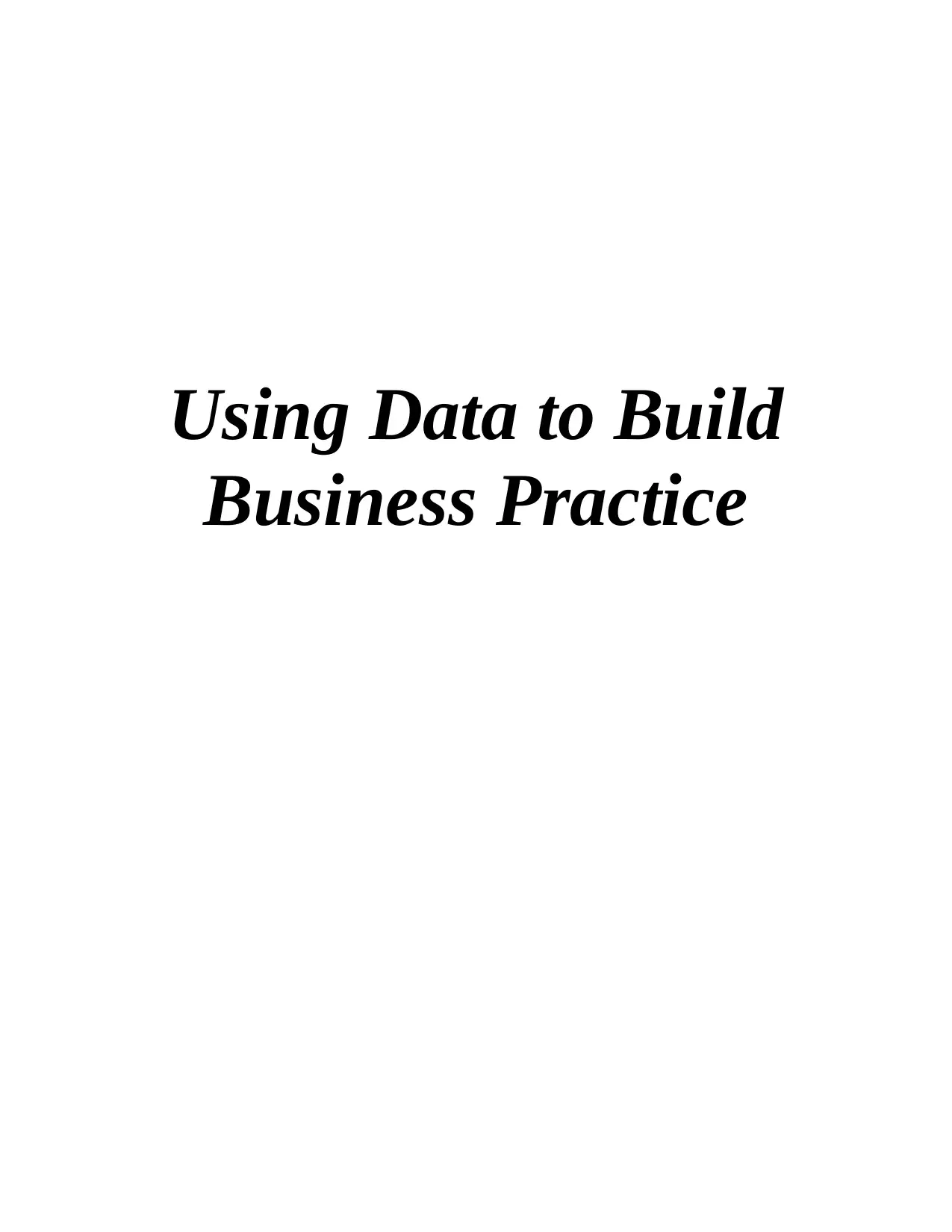
Using Data to Build
Business Practice
Business Practice
Paraphrase This Document
Need a fresh take? Get an instant paraphrase of this document with our AI Paraphraser
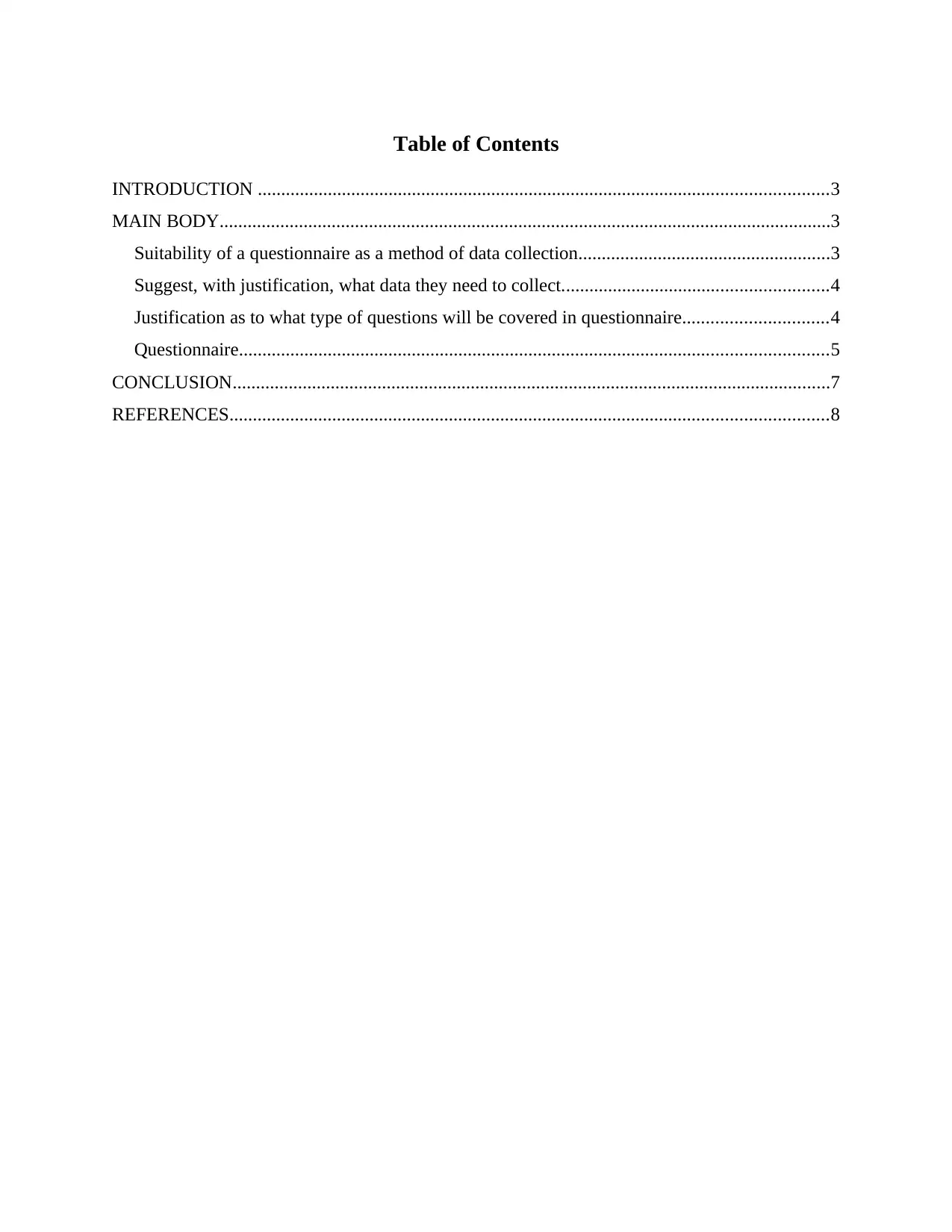
Table of Contents
INTRODUCTION ..........................................................................................................................3
MAIN BODY...................................................................................................................................3
Suitability of a questionnaire as a method of data collection......................................................3
Suggest, with justification, what data they need to collect.........................................................4
Justification as to what type of questions will be covered in questionnaire...............................4
Questionnaire..............................................................................................................................5
CONCLUSION................................................................................................................................7
REFERENCES................................................................................................................................8
INTRODUCTION ..........................................................................................................................3
MAIN BODY...................................................................................................................................3
Suitability of a questionnaire as a method of data collection......................................................3
Suggest, with justification, what data they need to collect.........................................................4
Justification as to what type of questions will be covered in questionnaire...............................4
Questionnaire..............................................................................................................................5
CONCLUSION................................................................................................................................7
REFERENCES................................................................................................................................8
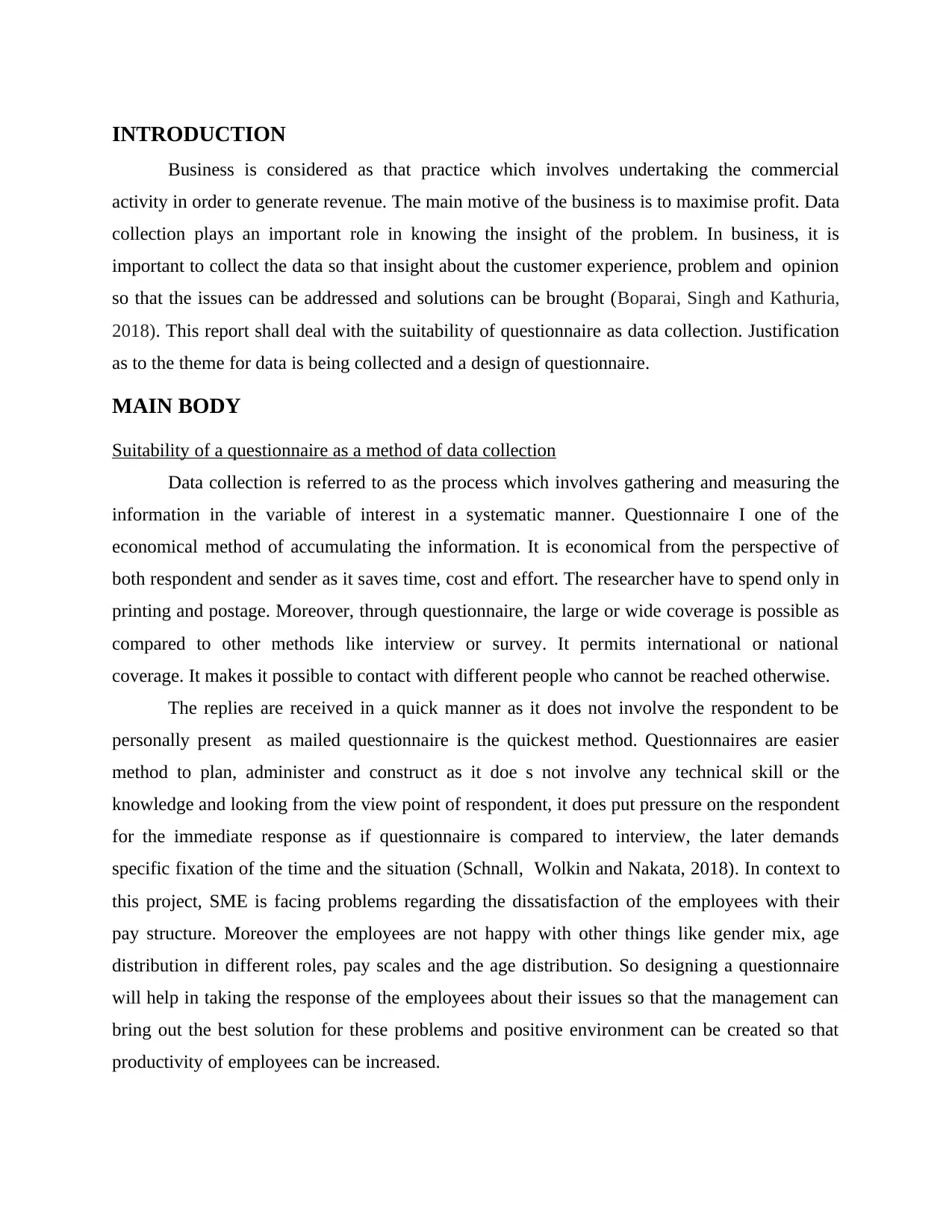
INTRODUCTION
Business is considered as that practice which involves undertaking the commercial
activity in order to generate revenue. The main motive of the business is to maximise profit. Data
collection plays an important role in knowing the insight of the problem. In business, it is
important to collect the data so that insight about the customer experience, problem and opinion
so that the issues can be addressed and solutions can be brought (Boparai, Singh and Kathuria,
2018). This report shall deal with the suitability of questionnaire as data collection. Justification
as to the theme for data is being collected and a design of questionnaire.
MAIN BODY
Suitability of a questionnaire as a method of data collection
Data collection is referred to as the process which involves gathering and measuring the
information in the variable of interest in a systematic manner. Questionnaire I one of the
economical method of accumulating the information. It is economical from the perspective of
both respondent and sender as it saves time, cost and effort. The researcher have to spend only in
printing and postage. Moreover, through questionnaire, the large or wide coverage is possible as
compared to other methods like interview or survey. It permits international or national
coverage. It makes it possible to contact with different people who cannot be reached otherwise.
The replies are received in a quick manner as it does not involve the respondent to be
personally present as mailed questionnaire is the quickest method. Questionnaires are easier
method to plan, administer and construct as it doe s not involve any technical skill or the
knowledge and looking from the view point of respondent, it does put pressure on the respondent
for the immediate response as if questionnaire is compared to interview, the later demands
specific fixation of the time and the situation (Schnall, Wolkin and Nakata, 2018). In context to
this project, SME is facing problems regarding the dissatisfaction of the employees with their
pay structure. Moreover the employees are not happy with other things like gender mix, age
distribution in different roles, pay scales and the age distribution. So designing a questionnaire
will help in taking the response of the employees about their issues so that the management can
bring out the best solution for these problems and positive environment can be created so that
productivity of employees can be increased.
Business is considered as that practice which involves undertaking the commercial
activity in order to generate revenue. The main motive of the business is to maximise profit. Data
collection plays an important role in knowing the insight of the problem. In business, it is
important to collect the data so that insight about the customer experience, problem and opinion
so that the issues can be addressed and solutions can be brought (Boparai, Singh and Kathuria,
2018). This report shall deal with the suitability of questionnaire as data collection. Justification
as to the theme for data is being collected and a design of questionnaire.
MAIN BODY
Suitability of a questionnaire as a method of data collection
Data collection is referred to as the process which involves gathering and measuring the
information in the variable of interest in a systematic manner. Questionnaire I one of the
economical method of accumulating the information. It is economical from the perspective of
both respondent and sender as it saves time, cost and effort. The researcher have to spend only in
printing and postage. Moreover, through questionnaire, the large or wide coverage is possible as
compared to other methods like interview or survey. It permits international or national
coverage. It makes it possible to contact with different people who cannot be reached otherwise.
The replies are received in a quick manner as it does not involve the respondent to be
personally present as mailed questionnaire is the quickest method. Questionnaires are easier
method to plan, administer and construct as it doe s not involve any technical skill or the
knowledge and looking from the view point of respondent, it does put pressure on the respondent
for the immediate response as if questionnaire is compared to interview, the later demands
specific fixation of the time and the situation (Schnall, Wolkin and Nakata, 2018). In context to
this project, SME is facing problems regarding the dissatisfaction of the employees with their
pay structure. Moreover the employees are not happy with other things like gender mix, age
distribution in different roles, pay scales and the age distribution. So designing a questionnaire
will help in taking the response of the employees about their issues so that the management can
bring out the best solution for these problems and positive environment can be created so that
productivity of employees can be increased.
⊘ This is a preview!⊘
Do you want full access?
Subscribe today to unlock all pages.

Trusted by 1+ million students worldwide
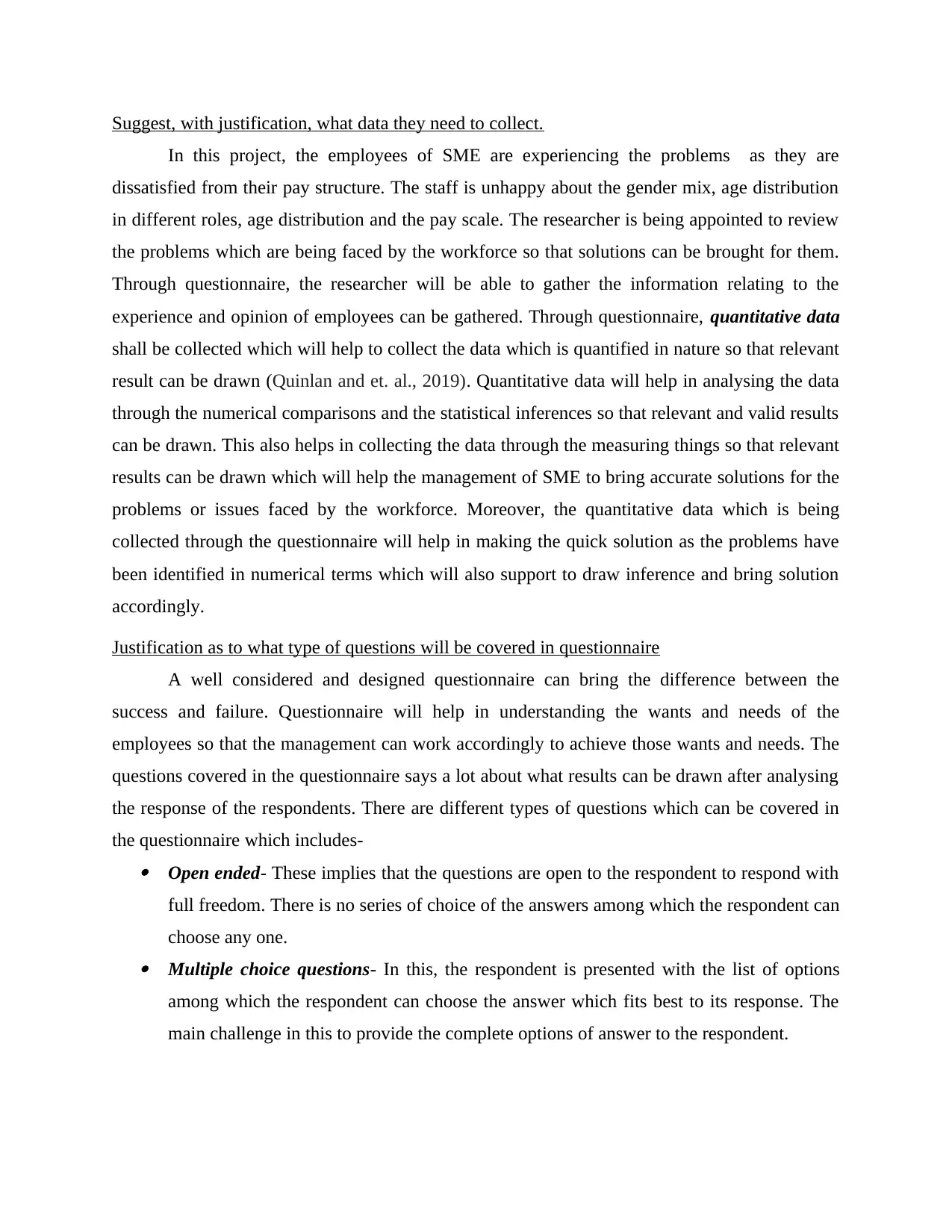
Suggest, with justification, what data they need to collect.
In this project, the employees of SME are experiencing the problems as they are
dissatisfied from their pay structure. The staff is unhappy about the gender mix, age distribution
in different roles, age distribution and the pay scale. The researcher is being appointed to review
the problems which are being faced by the workforce so that solutions can be brought for them.
Through questionnaire, the researcher will be able to gather the information relating to the
experience and opinion of employees can be gathered. Through questionnaire, quantitative data
shall be collected which will help to collect the data which is quantified in nature so that relevant
result can be drawn (Quinlan and et. al., 2019). Quantitative data will help in analysing the data
through the numerical comparisons and the statistical inferences so that relevant and valid results
can be drawn. This also helps in collecting the data through the measuring things so that relevant
results can be drawn which will help the management of SME to bring accurate solutions for the
problems or issues faced by the workforce. Moreover, the quantitative data which is being
collected through the questionnaire will help in making the quick solution as the problems have
been identified in numerical terms which will also support to draw inference and bring solution
accordingly.
Justification as to what type of questions will be covered in questionnaire
A well considered and designed questionnaire can bring the difference between the
success and failure. Questionnaire will help in understanding the wants and needs of the
employees so that the management can work accordingly to achieve those wants and needs. The
questions covered in the questionnaire says a lot about what results can be drawn after analysing
the response of the respondents. There are different types of questions which can be covered in
the questionnaire which includes- Open ended- These implies that the questions are open to the respondent to respond with
full freedom. There is no series of choice of the answers among which the respondent can
choose any one. Multiple choice questions- In this, the respondent is presented with the list of options
among which the respondent can choose the answer which fits best to its response. The
main challenge in this to provide the complete options of answer to the respondent.
In this project, the employees of SME are experiencing the problems as they are
dissatisfied from their pay structure. The staff is unhappy about the gender mix, age distribution
in different roles, age distribution and the pay scale. The researcher is being appointed to review
the problems which are being faced by the workforce so that solutions can be brought for them.
Through questionnaire, the researcher will be able to gather the information relating to the
experience and opinion of employees can be gathered. Through questionnaire, quantitative data
shall be collected which will help to collect the data which is quantified in nature so that relevant
result can be drawn (Quinlan and et. al., 2019). Quantitative data will help in analysing the data
through the numerical comparisons and the statistical inferences so that relevant and valid results
can be drawn. This also helps in collecting the data through the measuring things so that relevant
results can be drawn which will help the management of SME to bring accurate solutions for the
problems or issues faced by the workforce. Moreover, the quantitative data which is being
collected through the questionnaire will help in making the quick solution as the problems have
been identified in numerical terms which will also support to draw inference and bring solution
accordingly.
Justification as to what type of questions will be covered in questionnaire
A well considered and designed questionnaire can bring the difference between the
success and failure. Questionnaire will help in understanding the wants and needs of the
employees so that the management can work accordingly to achieve those wants and needs. The
questions covered in the questionnaire says a lot about what results can be drawn after analysing
the response of the respondents. There are different types of questions which can be covered in
the questionnaire which includes- Open ended- These implies that the questions are open to the respondent to respond with
full freedom. There is no series of choice of the answers among which the respondent can
choose any one. Multiple choice questions- In this, the respondent is presented with the list of options
among which the respondent can choose the answer which fits best to its response. The
main challenge in this to provide the complete options of answer to the respondent.
Paraphrase This Document
Need a fresh take? Get an instant paraphrase of this document with our AI Paraphraser
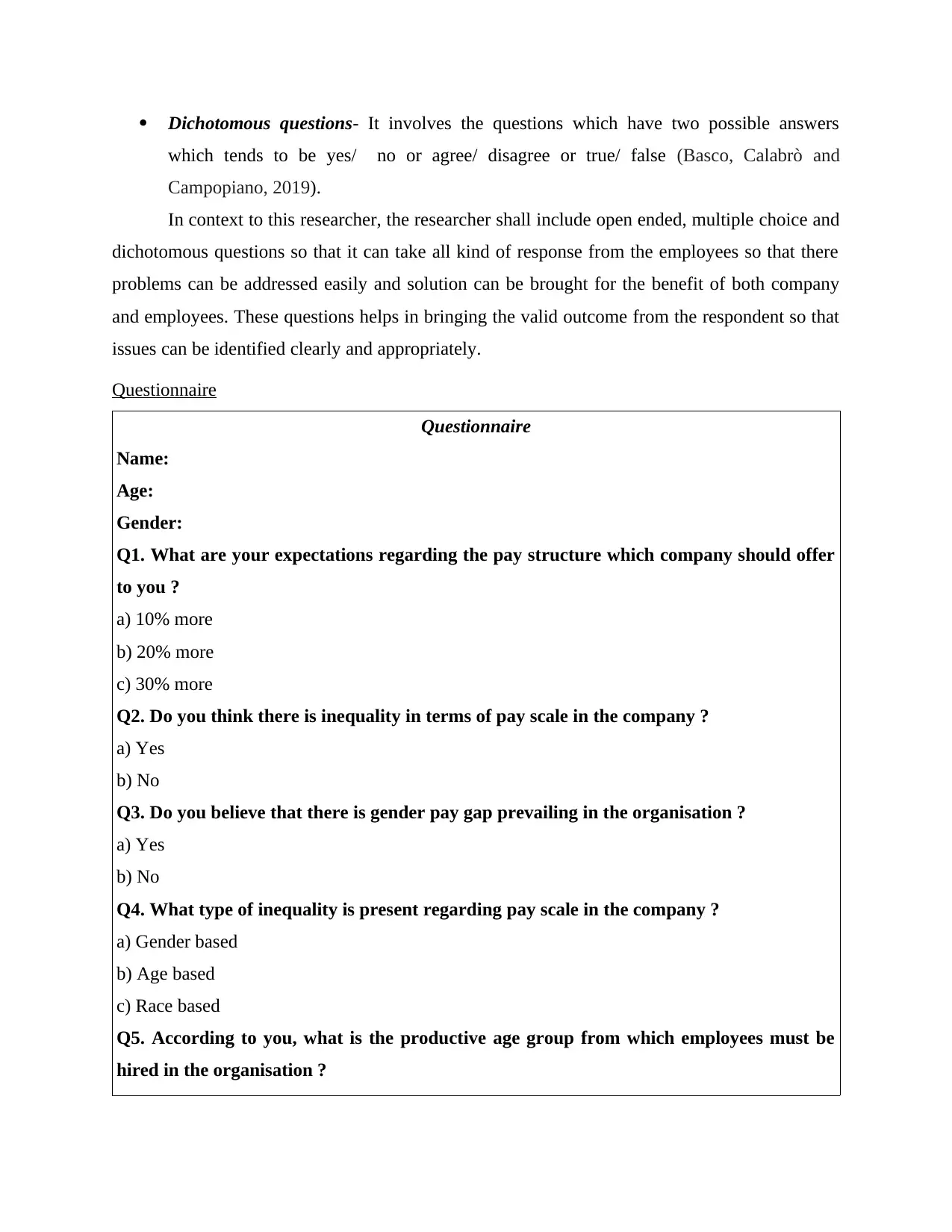
Dichotomous questions- It involves the questions which have two possible answers
which tends to be yes/ no or agree/ disagree or true/ false (Basco, Calabrò and
Campopiano, 2019).
In context to this researcher, the researcher shall include open ended, multiple choice and
dichotomous questions so that it can take all kind of response from the employees so that there
problems can be addressed easily and solution can be brought for the benefit of both company
and employees. These questions helps in bringing the valid outcome from the respondent so that
issues can be identified clearly and appropriately.
Questionnaire
Questionnaire
Name:
Age:
Gender:
Q1. What are your expectations regarding the pay structure which company should offer
to you ?
a) 10% more
b) 20% more
c) 30% more
Q2. Do you think there is inequality in terms of pay scale in the company ?
a) Yes
b) No
Q3. Do you believe that there is gender pay gap prevailing in the organisation ?
a) Yes
b) No
Q4. What type of inequality is present regarding pay scale in the company ?
a) Gender based
b) Age based
c) Race based
Q5. According to you, what is the productive age group from which employees must be
hired in the organisation ?
which tends to be yes/ no or agree/ disagree or true/ false (Basco, Calabrò and
Campopiano, 2019).
In context to this researcher, the researcher shall include open ended, multiple choice and
dichotomous questions so that it can take all kind of response from the employees so that there
problems can be addressed easily and solution can be brought for the benefit of both company
and employees. These questions helps in bringing the valid outcome from the respondent so that
issues can be identified clearly and appropriately.
Questionnaire
Questionnaire
Name:
Age:
Gender:
Q1. What are your expectations regarding the pay structure which company should offer
to you ?
a) 10% more
b) 20% more
c) 30% more
Q2. Do you think there is inequality in terms of pay scale in the company ?
a) Yes
b) No
Q3. Do you believe that there is gender pay gap prevailing in the organisation ?
a) Yes
b) No
Q4. What type of inequality is present regarding pay scale in the company ?
a) Gender based
b) Age based
c) Race based
Q5. According to you, what is the productive age group from which employees must be
hired in the organisation ?
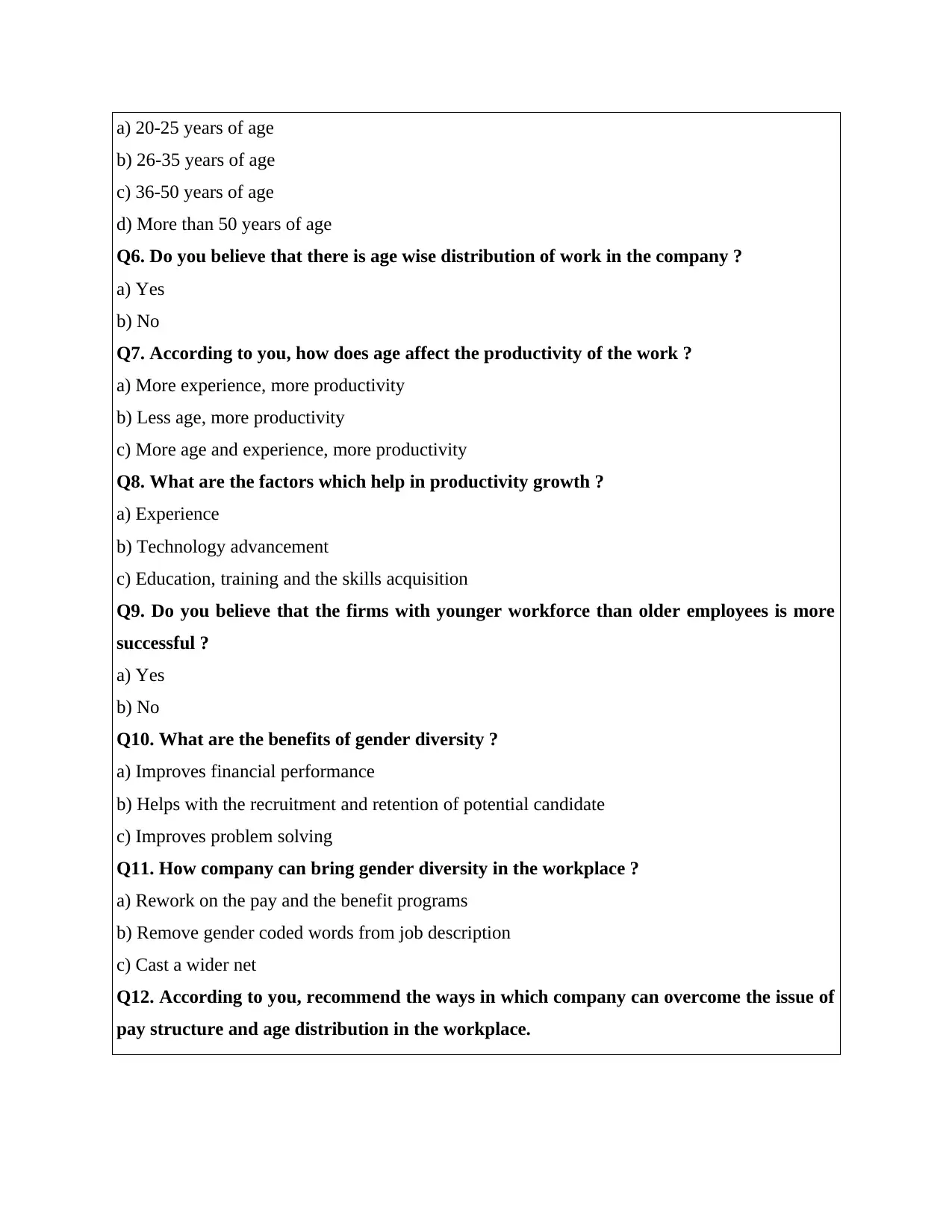
a) 20-25 years of age
b) 26-35 years of age
c) 36-50 years of age
d) More than 50 years of age
Q6. Do you believe that there is age wise distribution of work in the company ?
a) Yes
b) No
Q7. According to you, how does age affect the productivity of the work ?
a) More experience, more productivity
b) Less age, more productivity
c) More age and experience, more productivity
Q8. What are the factors which help in productivity growth ?
a) Experience
b) Technology advancement
c) Education, training and the skills acquisition
Q9. Do you believe that the firms with younger workforce than older employees is more
successful ?
a) Yes
b) No
Q10. What are the benefits of gender diversity ?
a) Improves financial performance
b) Helps with the recruitment and retention of potential candidate
c) Improves problem solving
Q11. How company can bring gender diversity in the workplace ?
a) Rework on the pay and the benefit programs
b) Remove gender coded words from job description
c) Cast a wider net
Q12. According to you, recommend the ways in which company can overcome the issue of
pay structure and age distribution in the workplace.
b) 26-35 years of age
c) 36-50 years of age
d) More than 50 years of age
Q6. Do you believe that there is age wise distribution of work in the company ?
a) Yes
b) No
Q7. According to you, how does age affect the productivity of the work ?
a) More experience, more productivity
b) Less age, more productivity
c) More age and experience, more productivity
Q8. What are the factors which help in productivity growth ?
a) Experience
b) Technology advancement
c) Education, training and the skills acquisition
Q9. Do you believe that the firms with younger workforce than older employees is more
successful ?
a) Yes
b) No
Q10. What are the benefits of gender diversity ?
a) Improves financial performance
b) Helps with the recruitment and retention of potential candidate
c) Improves problem solving
Q11. How company can bring gender diversity in the workplace ?
a) Rework on the pay and the benefit programs
b) Remove gender coded words from job description
c) Cast a wider net
Q12. According to you, recommend the ways in which company can overcome the issue of
pay structure and age distribution in the workplace.
⊘ This is a preview!⊘
Do you want full access?
Subscribe today to unlock all pages.

Trusted by 1+ million students worldwide

Paraphrase This Document
Need a fresh take? Get an instant paraphrase of this document with our AI Paraphraser
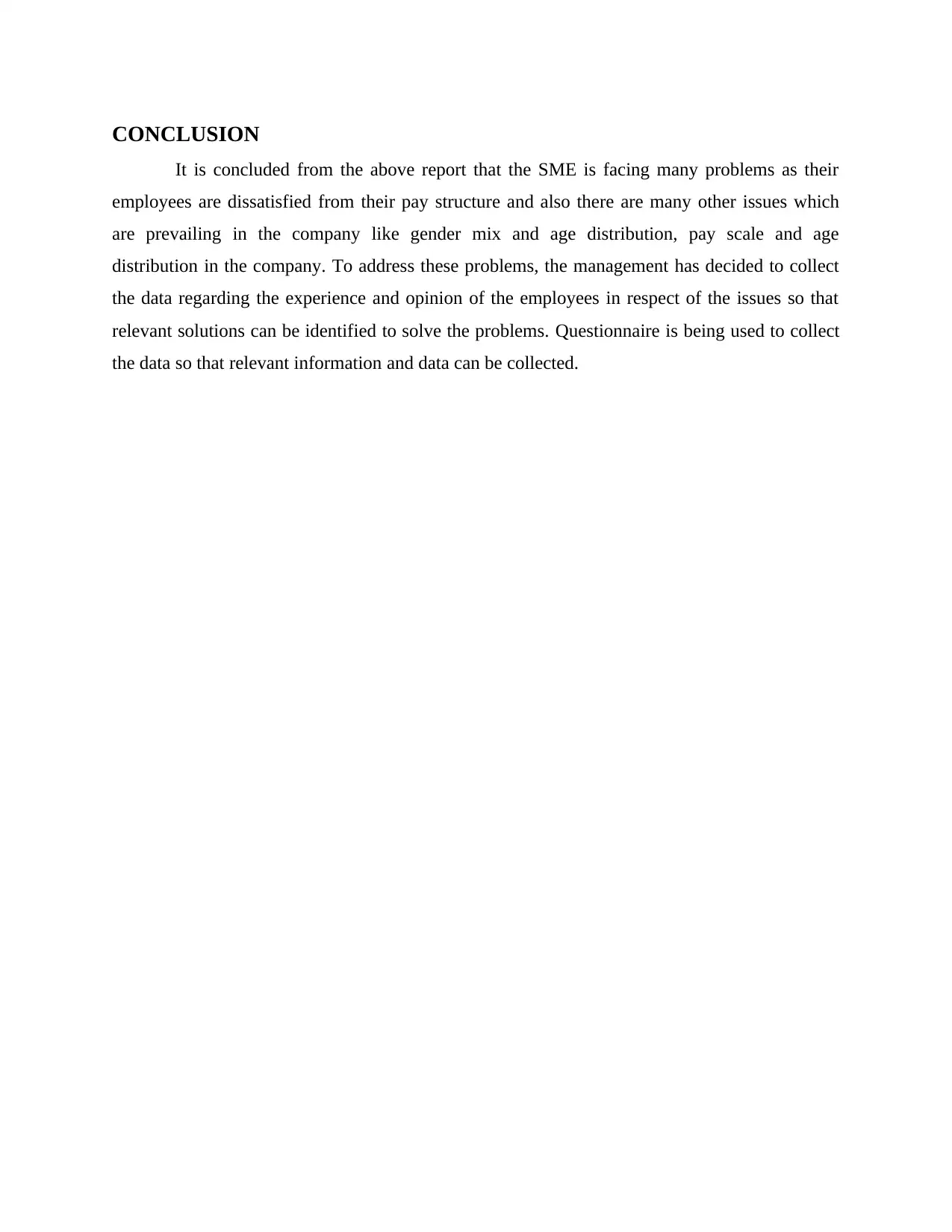
CONCLUSION
It is concluded from the above report that the SME is facing many problems as their
employees are dissatisfied from their pay structure and also there are many other issues which
are prevailing in the company like gender mix and age distribution, pay scale and age
distribution in the company. To address these problems, the management has decided to collect
the data regarding the experience and opinion of the employees in respect of the issues so that
relevant solutions can be identified to solve the problems. Questionnaire is being used to collect
the data so that relevant information and data can be collected.
It is concluded from the above report that the SME is facing many problems as their
employees are dissatisfied from their pay structure and also there are many other issues which
are prevailing in the company like gender mix and age distribution, pay scale and age
distribution in the company. To address these problems, the management has decided to collect
the data regarding the experience and opinion of the employees in respect of the issues so that
relevant solutions can be identified to solve the problems. Questionnaire is being used to collect
the data so that relevant information and data can be collected.
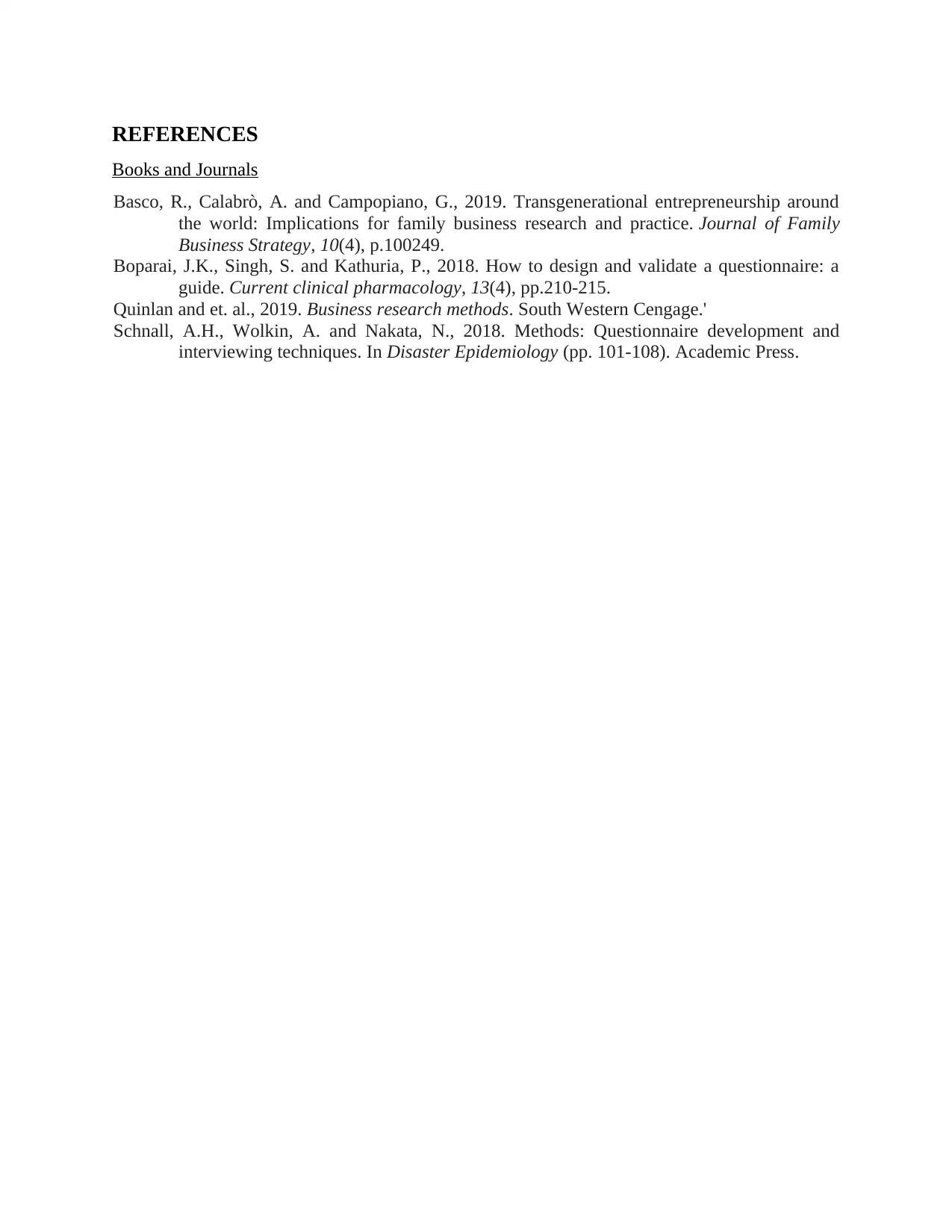
REFERENCES
Books and Journals
Basco, R., Calabrò, A. and Campopiano, G., 2019. Transgenerational entrepreneurship around
the world: Implications for family business research and practice. Journal of Family
Business Strategy, 10(4), p.100249.
Boparai, J.K., Singh, S. and Kathuria, P., 2018. How to design and validate a questionnaire: a
guide. Current clinical pharmacology, 13(4), pp.210-215.
Quinlan and et. al., 2019. Business research methods. South Western Cengage.'
Schnall, A.H., Wolkin, A. and Nakata, N., 2018. Methods: Questionnaire development and
interviewing techniques. In Disaster Epidemiology (pp. 101-108). Academic Press.
Books and Journals
Basco, R., Calabrò, A. and Campopiano, G., 2019. Transgenerational entrepreneurship around
the world: Implications for family business research and practice. Journal of Family
Business Strategy, 10(4), p.100249.
Boparai, J.K., Singh, S. and Kathuria, P., 2018. How to design and validate a questionnaire: a
guide. Current clinical pharmacology, 13(4), pp.210-215.
Quinlan and et. al., 2019. Business research methods. South Western Cengage.'
Schnall, A.H., Wolkin, A. and Nakata, N., 2018. Methods: Questionnaire development and
interviewing techniques. In Disaster Epidemiology (pp. 101-108). Academic Press.
⊘ This is a preview!⊘
Do you want full access?
Subscribe today to unlock all pages.

Trusted by 1+ million students worldwide
1 out of 9
Related Documents
Your All-in-One AI-Powered Toolkit for Academic Success.
+13062052269
info@desklib.com
Available 24*7 on WhatsApp / Email
![[object Object]](/_next/static/media/star-bottom.7253800d.svg)
Unlock your academic potential
Copyright © 2020–2025 A2Z Services. All Rights Reserved. Developed and managed by ZUCOL.





